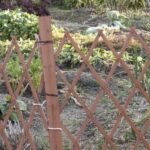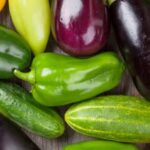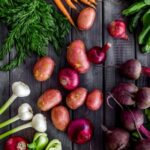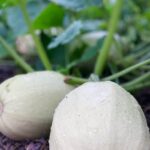As the vibrant colors of autumn begin to paint the landscape, North Carolina offers a stunning backdrop for fall vegetable gardening. Embracing the mild climate and rich soil of this region, many gardeners take advantage of the opportunity to grow a variety of delicious and nutritious vegetables during the fall season.
In this article, we will delve into the world of North Carolina fall vegetable gardening, exploring the benefits and beauty that comes with cultivating a bountiful garden during this time of year.
North Carolina fall vegetable gardening presents an opportunity for enthusiasts to extend their growing season and enjoy an abundant harvest well into the cooler months. With the right selection of crops and proper care, gardeners can experience a thriving garden throughout the autumn season. From leafy greens to root vegetables, there is a wide array of options to choose from when planning a fall garden in North Carolina.
In addition to reaping the rewards of a successful fall harvest, cultivating a vegetable garden in North Carolina during the autumn months allows individuals to connect with nature and embrace the seasonal changes that unfold around them. The crisp air, brilliant foliage, and earthy scents create an idyllic setting for those who appreciate the beauty of nature while tending to their gardens.
In this article, we will guide you through all the necessary steps for achieving a flourishing fall vegetable garden in North Carolina.
Best Fall Vegetables to Plant in North Carolina
When it comes to fall vegetable gardening in North Carolina, there are several crops that thrive in the state’s unique climate. These vegetables not only survive the cooler temperatures and shorter days of autumn but also provide a bountiful harvest for you to enjoy.
Some of the best fall vegetables to plant in North Carolina include leafy greens like kale, spinach, and lettuce. These cool-weather crops do well in North Carolina’s fall climate and can tolerate late-season heat as well.
Additionally, root vegetables such as carrots, beets, and radishes are excellent choices for a North Carolina fall garden. These hardy vegetables can be sown directly into the ground in late summer or early fall and will mature throughout the season. As a result, you’ll have delicious and fresh produce to enjoy during the cooler months.
Furthermore, cruciferous vegetables like broccoli, cauliflower, and Brussels sprouts also do exceptionally well in North Carolina’s fall climate. These plants benefit from the cooler temperatures and can produce an abundant harvest if planted at the right time. By including these top vegetable crops in your fall garden, you can take advantage of North Carolina’s ideal conditions for successful autumn gardening.
In addition to these vegetables, consider planting hardy herbs such as parsley and cilantro that thrive in the fall season. With careful planning and attention to planting schedules, you can create a diverse and thriving garden full of delicious produce during North Carolina’s fall months. So get ready to roll up your sleeves and start your north carolina fall vegetable gardening with these top vegetable crops.
Preparing Your Garden for Fall
As the summer season comes to an end in North Carolina, it’s time to start preparing your garden for a successful fall planting season. Cleaning up your summer garden and prepping the soil are essential steps to ensure that your fall vegetables thrive in North Carolina’s climate. Here are some tips to get your garden ready for the upcoming fall planting:
- Remove spent plants: Start by clearing out any remaining summer crops that have finished producing. This will create space for your new fall vegetable plants and help prevent disease and pest problems.
- Weed the garden: Take the time to pull out any weeds that have taken hold in your garden beds. Weeding now will make it easier to maintain a clean and healthy garden throughout the fall season.
- Amend the soil: Adding compost or organic matter to your garden beds will help replenish nutrients and improve soil structure. North Carolina’s fall vegetable gardening will benefit from well-amended soil, so take the time to work in these amendments before planting.
By following these cleaning and prepping tips, you’ll be setting the stage for a successful fall vegetable garden in North Carolina.
Once you’ve cleaned up your summer garden and prepped the soil, you’ll be ready to start planting your fall vegetables. Be sure to consult a local planting schedule or guide for specific timing recommendations based on your location within North Carolina. In general, here are some popular fall vegetables that thrive in North Carolina’s climate:
- Broccoli
- Cabbage
- Carrots
- Lettuce
- Spinach
These cool-season crops can withstand the fluctuating temperatures of North Carolina’s fall weather and provide a bountiful harvest for you to enjoy. With proper preparation and timing, your fall vegetable gardening efforts in North Carolina are sure to be rewarding.
Planting Schedule
When it comes to fall vegetable gardening in North Carolina, timing is everything. Knowing when to plant specific vegetables can make all the difference in ensuring a bountiful fall harvest. The climate in North Carolina varies from the mountains to the coast, so it’s important to take into account your specific location when planning your fall garden.
For a successful fall vegetable garden in North Carolina, it’s essential to pay close attention to the planting schedule. Cool-season vegetables such as broccoli, cabbage, carrots, and lettuce thrive in the milder temperatures of North Carolina’s fall season. Typically, these vegetables should be planted in late summer or early fall to allow them enough time to mature before the first frost.
In general, the best time to start planting fall vegetables in North Carolina is around mid-August to early September. This gives the plants enough time to establish themselves before temperatures start dropping.
However, it’s important to pay attention to the specific planting dates for each vegetable as they may vary slightly. By following a detailed planting schedule for North Carolina fall vegetable gardening, you can ensure that your garden is set up for success and that you’ll be enjoying a delicious harvest throughout the season.
Maintenance and Care
Fall is an ideal time for vegetable gardening in North Carolina, with its mild temperatures and abundant sunshine. However, as the season transitions from summer to fall, it’s important to adjust your maintenance and care routine to ensure a successful harvest. Proper watering, fertilizing, and pest control are essential for the health and productivity of your fall vegetable garden.
Watering
In North Carolina, fall typically brings drier weather compared to the summer months. It’s important to monitor soil moisture levels and water your vegetable garden as needed. Aim to provide around 1 inch of water per week, either through rainfall or irrigation. Be sure to water in the morning to allow foliage to dry out during the day, which can help prevent disease issues.
Fertilizing
Before planting your fall crops, it’s crucial to amend your soil with organic matter such as compost or well-decomposed manure. This will not only improve soil structure but also provide essential nutrients for your vegetables. As your plants grow, consider side-dressing with nitrogen-rich fertilizer or applying a balanced fertilizer according to package instructions to support robust growth and production.
Pest Control
Pests can still be active in the fall, so it’s important to keep an eye out for signs of infestation. Regularly inspect your plants for any pests or disease symptoms and take appropriate action if necessary. Consider using natural pest control methods such as hand-picking pests, applying insecticidal soaps or oils, or utilizing row covers to protect vulnerable plants from pests.
By implementing proper maintenance and care practices for your fall vegetable garden in North Carolina, you can ensure a bountiful harvest of fresh produce that will enhance your autumn meals and provide enjoyment throughout the season.
Extending the Season
As the temperatures start to drop and the days get shorter, it’s important to consider ways to extend the fall vegetable growing season in North Carolina. By utilizing various strategies, gardeners can continue to enjoy fresh produce well into the autumn months. Here are some effective methods for extending the season and maximizing your fall harvest:
Row Covers
Using row covers is an excellent way to protect your crops from cooler temperatures and light frosts. These lightweight, breathable fabrics help to trap heat around the plants, creating a microclimate that can keep them warm and thriving even as the weather cools down.
Mulching
Applying a layer of mulch around your plants can help regulate soil temperature and moisture levels. This not only protects the roots of your vegetables from extreme temperature fluctuations but also helps to suppress weed growth, making it easier for your fall crops to thrive.
Cold Frames
Cold frames are essentially miniature greenhouses that provide an enclosed environment for your plants. By using transparent materials such as plastic or glass, cold frames capture and retain heat from the sun, creating a warm space for vegetables to continue growing well into the colder months.
By implementing these strategies and staying attentive to changing weather patterns, North Carolina gardeners can enjoy an extended growing season for their fall vegetables. With some careful planning and maintenance, it’s possible to savor homegrown produce throughout the autumn months, adding freshness and flavor to meals even as winter approaches.
Harvesting and Enjoying
Knowing When to Harvest
As the temperatures start to cool down in North Carolina, it’s important to know when to harvest your fall vegetables. Different crops have different maturity times, so it’s crucial to keep an eye on them and harvest at the right time.
For example, leafy greens like kale and lettuce can be harvested as soon as they reach a usable size, while root vegetables like carrots and beets should be left in the ground until they reach their full maturity.
Preparing Your Fall Vegetable Bounty
Once you’ve harvested your fall vegetables, it’s time to prepare them for consumption. One of the best things about fall vegetable gardening in North Carolina is the abundance of fresh produce that can be used in delicious recipes.
From hearty stews and soups to roasted vegetable medleys, there are countless ways to enjoy the flavors of fall. Incorporating your freshly harvested vegetables into meals not only provides a sense of satisfaction but also ensures that you’re getting the maximum nutritional value from your garden.
Preservation Methods
In addition to immediate consumption, many fall vegetables can also be preserved for long-term use. Canning, pickling, and freezing are all effective methods for preserving the bounty of your fall garden. This allows you to enjoy the fruits of your labor well into the winter months. By learning these preservation techniques, you can savor the flavors of North Carolina fall vegetable gardening year-round.
By making the most of your fall vegetable harvest through proper harvesting methods, preparation for consumption and preservation techniques, you can fully enjoy the rewards of your hard work in North Carolina’s beautiful autumn season.
Conclusion
In conclusion, fall vegetable gardening in North Carolina offers a bountiful harvest and numerous benefits for gardeners. Not only does the cooler weather provide the perfect conditions for certain crops to thrive, but it also allows for an extended growing season compared to other regions. By taking advantage of planting schedules and following maintenance and care tips, North Carolinians can enjoy a variety of fresh vegetables well into the fall months.
The beauty of North Carolina in the fall serves as the perfect backdrop for an abundance of colorful and flavorful vegetables. From hearty root vegetables like carrots and turnips to leafy greens like kale and spinach, there are plenty of options to choose from when planning a fall garden. Additionally, extending the season through techniques such as using row covers or cold frames can further enhance the potential yield of a fall vegetable garden in North Carolina.
As we wrap up this guide on fall vegetable gardening in North Carolina, we encourage our readers to get started with their own fall gardens. Whether you are an experienced gardener or just starting out, the benefits of cultivating your own fresh produce during the autumn months are truly rewarding.
With proper preparation, care, and dedication, anyone can experience the joy of harvesting and enjoying their own homegrown vegetables throughout the fall season in North Carolina. So grab your gardening tools and get ready to plant your very own North Carolina fall vegetable garden.
Frequently Asked Questions
When Should I Start a Fall Garden in North Carolina?
In North Carolina, the ideal time to start a fall garden is in late summer, around August or early September. This gives the vegetables enough time to mature before the first frost.
What Vegetables Can I Plant in September in North Carolina?
Some of the vegetables that can be planted in North Carolina in September include broccoli, cabbage, carrots, cauliflower, kale, lettuce, radishes, and spinach. These cool-season crops thrive in the milder fall temperatures.
When Should I Start My Fall Vegetable Garden?
It is recommended to start your fall vegetable garden about 6-8 weeks before the first expected frost. For North Carolina, this means starting in late summer or early fall to ensure that the plants have enough time to grow and produce before winter arrives.

If you’re looking to get into vegetable gardening, or are just looking for some tips on how to make your current garden better, then you’ve come to the right place! My name is Ethel and I have been gardening for years. In this blog, I’m going to share with you some of my best tips on how to create a successful vegetable garden.





